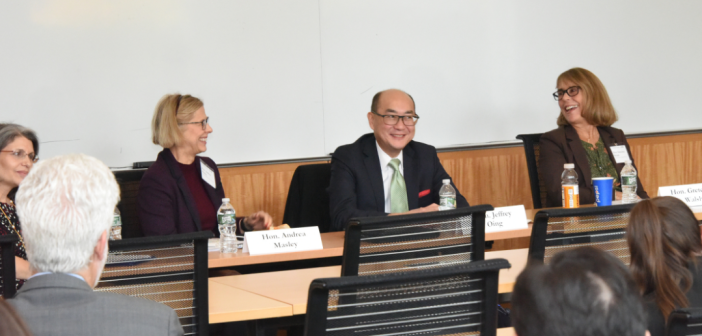From adjudicating commercial mortgage foreclosures and breaches of fiduciary duty, to high-stakes disputes involving crypto and the improper interference of exclusive merchandising agreements, judges of the Commercial Division of the New York Supreme Court see a vast array of commercial matters.
For example, when about $8 million of cryptocurrency was stolen in Liechtenstein in 2022, tracers had found that it had been transferred to a digital wallet in New York. So, when LCX cryptocurrency exchange asked New York County’s Commercial Division if they could serve the anonymous defendants with a temporary restraining order via a non-fungible token, Justice Andrea Masley ’91 permitted it—a first in the Court’s history (LCX AG vs. John Doe No. 1-25, index number 154644/2022).
“At the end of the day, it really wasn’t any different than snail mail or serving by Facebook or email,” Masley said. “I don’t think we’ve served by TikTok yet, but alternate forms of service have been given when there’s just no other way.”
Students and faculty gained such insights into the interesting work of the Commercial Division and its judges thanks to the latest installment of the View from Chambers series. This series is part of the Center for Judicial Events & Clerkships’ (CJEC) Judicial Engagement through Education Initiative, which shines a spotlight on a diverse slate of judges from a range of federal and state courts.
Presented in November by the CJEC and the Corporate Law Center (CLC), View from Chambers featured Masley, Justice Jeffrey Oing of the New York Supreme Court, Appellate Division (First Department), and Justice Gretchen Walsh ’87 of the New York Supreme Court, Commercial Division (Westchester County).

(L-R) Professor James Brudney, Professor Richard Squire, Justice Gretchen Walsh ’87, Justice Jeffrey Oing, Justice Andrea Masley ’91, Amy Martella ’07, and Suzanne M. Endrizzi ’96
The discussion explored the various roles and duties of judges on the court, the benefits to New York State of having this type of court, emerging trends in New York commercial law, and creative lawyering around contracts. The justices highlighted a range of attention-getting cases they have presided over involving celebrities like Martha Stewart and retailers like Macy’s and J.C. Penney.
The panelists spent the day at Fordham Law as part of the Institute on Complex Commercial Litigation, on which the CJEC and the Corporate Law Center worked collaboratively with the Commercial Division Advisory Council to host. The Institute trains Commercial Division judges and Appellate Division judges on issues related to commercial litigation. It was renamed this year as the Eileen Bransten Institute on Complex Commercial Litigation to honor Judge Eileen Bransten ’79, a justice on the Commercial Division of the New York Supreme Court who helped shape the Commercial Division during her decades-long career.
CJEC Assistant Dean Suzanne M. Endrizzi ’96 and CLC Executive Director Amy Martella ’07, who moderated the discussion, were appreciative that the judges volunteered during the Institute’s lunch to engage with the Law School community.
“When judges like Justices Masley, Walsh, and Oing take the time to shed light on their work and the career paths that led them to the bench, our students gain not only an appreciation for the unique courts that comprise our legal system, but inspiration for all of the directions our profession can take them,” said Martella.
“The preeminence of the Commercial Division of the Supreme Court of New York is central to New York being an attractive business environment. We were honored to host the Court for the Institute and to host this panel for our community,” said Endrizzi.



